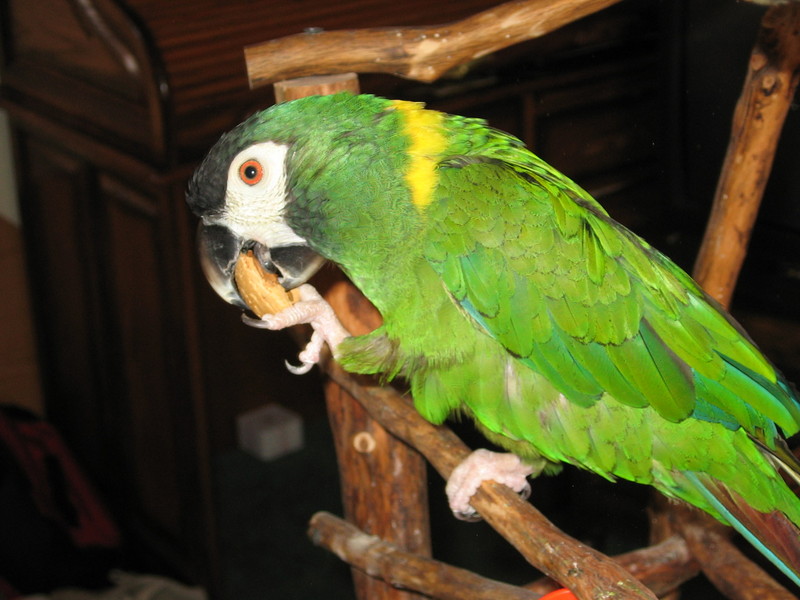Macaw (Psittacidae) - Wiki Macaw
From Wikipedia, the free encyclopedia
[Photo] Golden-collared Macaw (Propyrrhura auricollis). Date 2006-05-21. Author Ginkgo100 http://commons.wikimedia.org/wiki/User:Ginkgo100
Macaws are large colorful New World parrots, classified into six of the many Psittacidae genera: Ara, Anodorhynchus, Cyanopsitta, Propyrrhura, Orthopsittaca, and Diopsittaca. They are the largest birds in the parrot family in length and wingspan, though the flightless Kakapo is heavier.
Parrots are zygodactyl, like woodpeckers, having 4 toes on each foot ??? two front and two back.
Their native habitats are the forests, especially rain forests, of Mexico and Central and South America. They are called guacamayos in Spanish and araras in Portuguese.
Species in taxonomic order
- Anodorhynchus
- - Anodorhynchus glaucus : Glaucous Macaw
- - Anodorhynchus hyacinthinus : Hyacinth Macaw
- - Anodorhynchus leari : Indigo Macaw or Lear's Macaw
- Cyanopsitta
- - Cyanopsitta spixii : Little Blue Macaw or Spix's Macaw
- Ara
- - Ara ararauna : Blue-and-yellow Macaw
- - Ara glaucogularis : Blue-throated Macaw
- - Ara militaris : Military Macaw
- - Ara ambiguus : Buffon's Macaw or Great Green Macaw
- - Ara macao : Scarlet Macaw or Aracanga
- - Ara chloroptera : Greenwing Macaw or Red-and-green Macaw
- - Ara rubrogenys : Red-fronted Macaw
- - Ara severa : Chestnut-fronted Macaw or Severe Macaw
- - Ara atwoodi : Dominican Green-and-Yellow Macaw
- - Ara erythrocephala : Jamaican Green-and-Yellow Macaw
- - Ara gossei : Jamaican Red Macaw
- - Ara guadeloupensis : Lesser Antillean Macaw
- - Ara tricolor : Cuban Red Macaw
- - Ara autocthones : Saint Croix Macaw[1]
- Orthopsittaca
- - Orthopsittaca manilata : Red-bellied Macaw
- Propyrrhura
- - Propyrrhura couloni : Blue-headed Macaw
- - Propyrrhura maracana : Illiger's Macaw or Blue-winged Macaw
- - Propyrrhura auricollis : Golden-collared Macaw
- Diopsittaca
- - Diopsittaca nobilis : Red-shouldered Macaw or Hahn's Macaw
Status
The majority of macaws are now endangered in the wild. Five species are already extinct, and Spix's Macaw is now considered to be extinct in the wild. The Glaucous Macaw is also probably extinct, with only two reliable records of sightings in the 20th century. The greatest problems threatening the macaw population are the rapid rate of deforestation and the illegal trapping of birds for the bird trade.
Status
The majority of macaws are now endangered in the wild. Five species are already extinct, and Spix's Macaw is now considered to be extinct in the wild. The Glaucous Macaw is also probably extinct, with only two reliable records of sightings in the 20th century. The greatest problems threatening the macaw population are the rapid rate of deforestation and the illegal trapping of birds for the bird trade.
Birds in captivity
Macaws eat nuts and fruit. They also gnaw and chew on various objects. They show a large amount of intelligence in their behaviour and require constant intellectual stimulation to satisfy their innate curiosity.
Bonding: Macaws have been said to live for up to 100 years; however, an average of 50 years is probably more accurate. The larger macaws may live up to 65 years. They are monogamous and mate for life. In captivity unmated macaws will bond primarily with one person ??? their keeper. Pet macaws thrive on frequent interaction, and a lack of this can lead to their mental and physical suffering.
Other sub-bondings also take place and most macaws that are subjected to non-aggressive behavior will trust most humans, and can be handled even by strangers if someone familiar is also alongside.
Captive pet macaws sometimes display difficult behavior, the most common being biting, screaming, and feather-plucking. Feather-plucking does not normally occur in the wild, strongly suggesting that it is the result of a neurosis related to life in captivity.
Most pet macaws had ancestors living in the wild just two or three generations ago, and are not truly domesticated by any reasonable definition. (This is unlike, for example, dogs; some estimates put the domestication of dogs as far back as 40,000 years ago.)
All species of macaws have very powerful, large beaks and are capable of causing considerable harm to both children and adults. They tend to be extremely loud: their voices are designed to carry over long distances. This makes macaws very demanding birds to keep as a household pet. Additional complications arise from the intelligence levels of macaws and their negative responses to stimuli people generally use on domestic pets.
International trade in Macaws is illegal under the CITES agreement. Only captive born birds may be sold as pets.
Hybrids
A common trend in recent years is hybridising macaws for the pet trade. Hybrids are typical macaws, with the only difference from true species being their genetics and their colors. They tend to have intermediate characteristics between the parents', though the appearance seems to be influenced more by the father's genes. As for their temperament and behaviour, they seem to inherit the best of both parents, assuming both parents are not aggressive. Common hybrids include Harlequins (Ara ararauna x chloroptera) and Catalinas (known as Rainbows in Australia, A. ararauna x macao).[2] As many species of macaws will become extinct in the wild it is necessary to maintain pure breeding stock of captive macaws to ensure species preservation. As hybridizing dilutes the available gene pool it simply hastens species extinction. Please consider this before purchasing or breeding hybrids.
Strange Diet
Macaws are known to eat clay as an antidote to the poisonous seeds they eat. Scientists have found out that the chemicals in clay mix with the poison allowing to pass through the bird's digestive system unharmed.
http://en.wikipedia.org/wiki/Macaw
| The text in this page is based on the copyrighted Wikipedia article shown in above URL. It is used under the GNU Free Documentation License. You may redistribute it, verbatim or modified, providing that you comply with the terms of the GFDL. |
